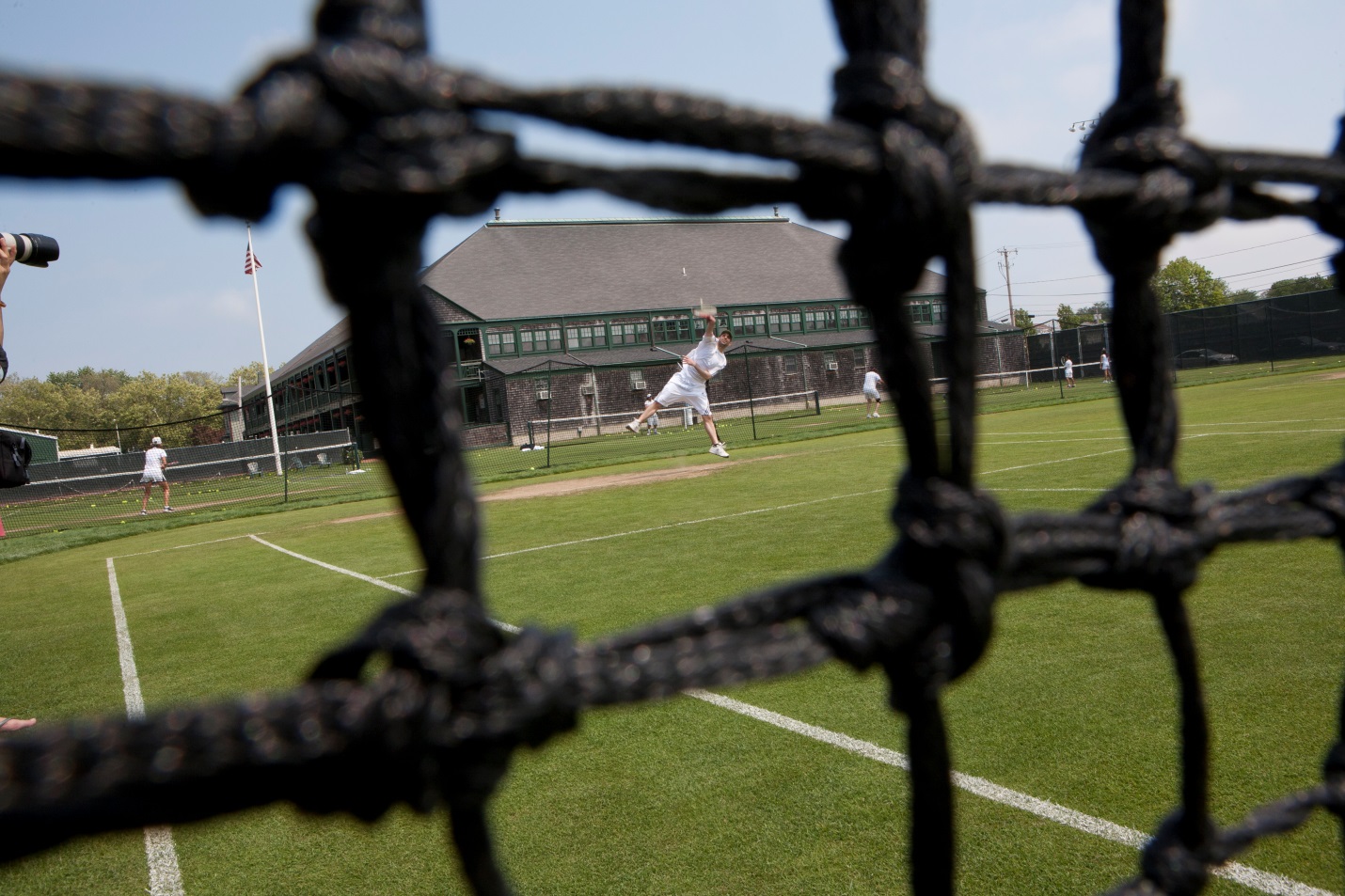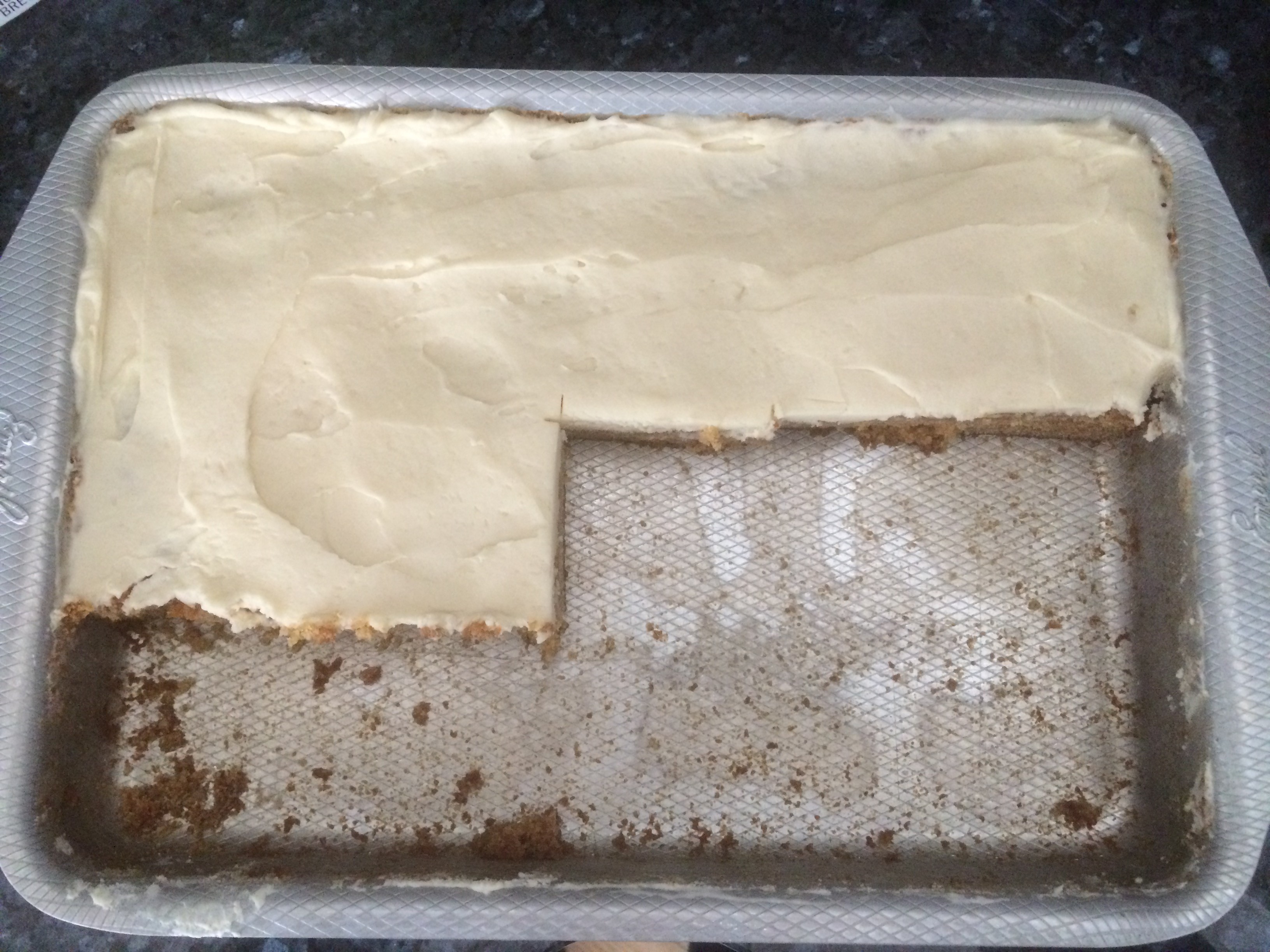“I have chosen to reword and publish the following text that, when I first wrote it, was never intended for posting.”
Our patients come here with all sorts of opportunities for improvement, but the common theme is that virtually all of these conditions require long-term management. Eating disorders can be worked through and overcome, cholesterol levels can be improved and maintained, but nobody accomplishes these or similar feats after a single session. Whatever our challenges, long-term success grows out of patience, perseverance, and finding a sustainable balance that enables us to manage our conditions in the context of our lives.
Practitioners are no different. Taking care of my chronic back woes involves the same sort of day-to-day management and balance that our patients face with their own conditions. Just as many of our patients do, I have my good days and my not so good days, and my motivation oscillates from time to time. Being a health care professional does not exempt me from being human.
Self-disclosure is a tricky issue, and while there are certainly wrong ways to go about it, there is not a singular right way either. My approach has always been that if sharing information about myself enhances patient care, then I am open to it.
For that reason, I have chosen to reword and publish the following text that, when I first wrote it, was never intended for posting. Meant for nobody but myself, it was an internal document, a tool in my decision-making process as I weighed whether or not to have another operation on my back. Writing out the intertwined relationship between my health and the sport that I love helped me to resolve my ambivalence, move from Contemplation to Preparation, and make a decision regarding surgery.
“The sport came naturally to me and I instantly fell in love with it.”
At a young age, I discovered that nowhere feels like home like a tennis court. My brother, four years my senior, was a standout baseball player and I had to go to virtually all of his games, or at least it felt that way. Back then, I appreciated neither the sport of baseball nor the importance of supporting a family member, so I spent the games sulking in boredom. In order to give me something to do, my mom gave me her old wooden tennis racquet and let me hit against a backboard near the baseball diamond. Anybody at my wedding who saw me out on the dance floor with Joanne can attest that I am one of the least coordinated people to ever walk the earth, but for some reason I had a specific talent for hitting a tennis ball. The sport came naturally to me and I instantly fell in love with it.
Hitting against the backboard segued to Park and Rec group lessons and then to private lessons with Ben, a family friend just a few years older than me who was one of the best players in town. My parents, neither of whom had a whole lot of experience with the sport, bought a couple of racquets for themselves so they could hit with me. One summer day when I was probably 13, my father and I finished hitting on the courts next to Needham High School and sat down on the steps that overlook Memorial Field. He told me that if I wanted to play for the team when I got to high school, he thought I could make it. I didn’t believe him.
“Approximately 20 spots later, in next-to-last place, was my name.”
While I had a talent for hitting ground strokes, tennis involves a whole lot more than that. When I got to high school and tried out for the team, I felt overmatched by players with more well-rounded games and experience. After Coach Shea cut my friend Todd, who in my mind was a much better player than I was, I figured I was destined for the same fate. Not until Coach assigned me a locker did I realize I had made the roster. He posted a ladder that ranked everybody on the team relative to each other. Ben was first, a spot he most certainly deserved and would ordinarily have occupied anyway, but in this case it was just symbolic, as he was unable to play due to a brain tumor. Approximately 20 spots later, in next-to-last place, was my name.
My first match was in Walpole on a chilly March day in 1992. I paired with my friend Josh, the sole player on the team ranked behind me, for a doubles match. Our opponents were two disheveled kids who kept on complaining that we had to hurry up because they had to get to some store before it closed. We managed to hold serve once, but that was all as we lost the one-set match 1-6. Before I knew it, we were off the court and back on the bus with our teammates, almost all of whom had won their matches. One of them greeted us with, “Wait, you LOST???”
Tryouts were rough my sophomore year, too. Still one of the weaker players on the team, I now had to compete for a roster spot against the incoming freshman as well. After I lost a “challenge match,” a one-on-one battle that determines who moves up and down the team’s ladder, against one of those freshmen, Coach told me he was considering cutting me. He let me stick around, but I had a tough season and finished with around a .500 record.
“With all of the losses I have had in approximately two decades of playing competitive tennis, this is the one that I wish I could have back.”
During tryouts my junior year, I drilled one of my teammates in the crotch with a two-handed backhand when he came to net. The ball’s direction was a complete accident and I felt bad that my shot put him on the ground in pain. On the other hand, that backhand got Coach’s attention. Every rep of my off-season weight training went into that passing shot. Coach knew I had worked hard coming into the season, and it proved to be the only year out of my four in high school that he gave me a spot on the roster without hesitation.
Early in the season, I played a challenge match against Andy, a very solid player with an excellent game. To the shock of everybody, including Andy and myself, I beat him. Upon leaving the court, Andy asked our Assistant Coach, “What’s he doing on JV?” As a result of my win, I shot up the ladder and played my first varsity match, second doubles, after a teammate was out sick.
A short time later, I was up against Jed, Ben’s younger brother, in another challenge match. Like Ben, Jed was an incredible player and I thought I had no chance. My intimidation showed as I lost the first set 0-6. Coach pulled me aside, calmed me down, and told me to play like I had against Andy. I won the second set. In the third set, I had a 5-3, 40-15 lead on Jed’s serve. Double break point, double match point, double by-far-the-biggest-victory-of-my-life point.
Jed took his time, methodically pacing in small circles behind the baseline before stepping up to serve. As the point evolved, he came to net and slammed an overhead that bounced high above my outstretched racquet. No problem, I thought; I still had match point. Jed again took his time to focus. He came in again and my down-the-line backhand passing shot failed to clear the net. Deuce. The self-doubt returned. Jed won four straight games to take the final set 7-5.
It’s not like I tanked. I tried my best during those last four games, but in my heart I felt that my window of opportunity had closed and that affected my play. To cap it off, I double faulted on Jed’s first match point. None of my teammates or coaches said one word to me after we walked off court. We all knew what had happened: I had choked. I had choked big time. With all of the losses I have had in approximately two decades of playing competitive tennis, this is the one that I wish I could have back, to see how my tennis future would have changed had I beaten a player of Jed’s stature at that point in my career.
“In a short span of time, my lack of confidence had been replaced by an exhibition of arrogance so obnoxious that I am still embarrassed of it to this day.”
Next season, with many great players still ahead of me on the ladder and a coach’s policy against playing seniors in JV matches, I had no spot on the team. Coach pulled me aside and explained that after three years together he felt too badly to cut me, but I should cut myself because I was not going to play. I refused to do so and remained on the roster as a practice player. After one of our best players was kicked off the team, I found a spot on varsity playing first doubles with Andy.
Our games blended nicely. My consistency and his power complemented each other well. Although we had both been on the team for years, we never really got to know each other until we were paired up for doubles. It turned out that we worked exceptionally well together. We each were capable of making the other one laugh, focus, calm down, fire up, whatever was called for in the given moment. Together, we had a swagger that neither one of us had on our own.
By the season’s midpoint, he and I were undefeated together. We were the top-ranked doubles team in our league and considered one of the best in the state. After defeating another highly-ranked doubles team in Brookline one afternoon, we walked off the court with my pointer finger held high in the air so everybody in attendance knew who was number one. In a short span of time, my lack of confidence had been replaced by an exhibition of arrogance so obnoxious that I am still embarrassed of it to this day.
After Andy and I lost a couple of matches, including one to a very weak tandem we should have dominated, Coach thought perhaps it was time to shake things up. While traveling home from a match, he sat across the bus aisle from me and asked what I thought about playing singles. Whatever the team needed, I told him, but my smile gave away the truth that I had badly wanted to be a varsity singles player for years. Coach shuffled the lineup and slotted me in at third singles, which remained my spot for the rest of the season while our team made it all the way to the state quarterfinals.
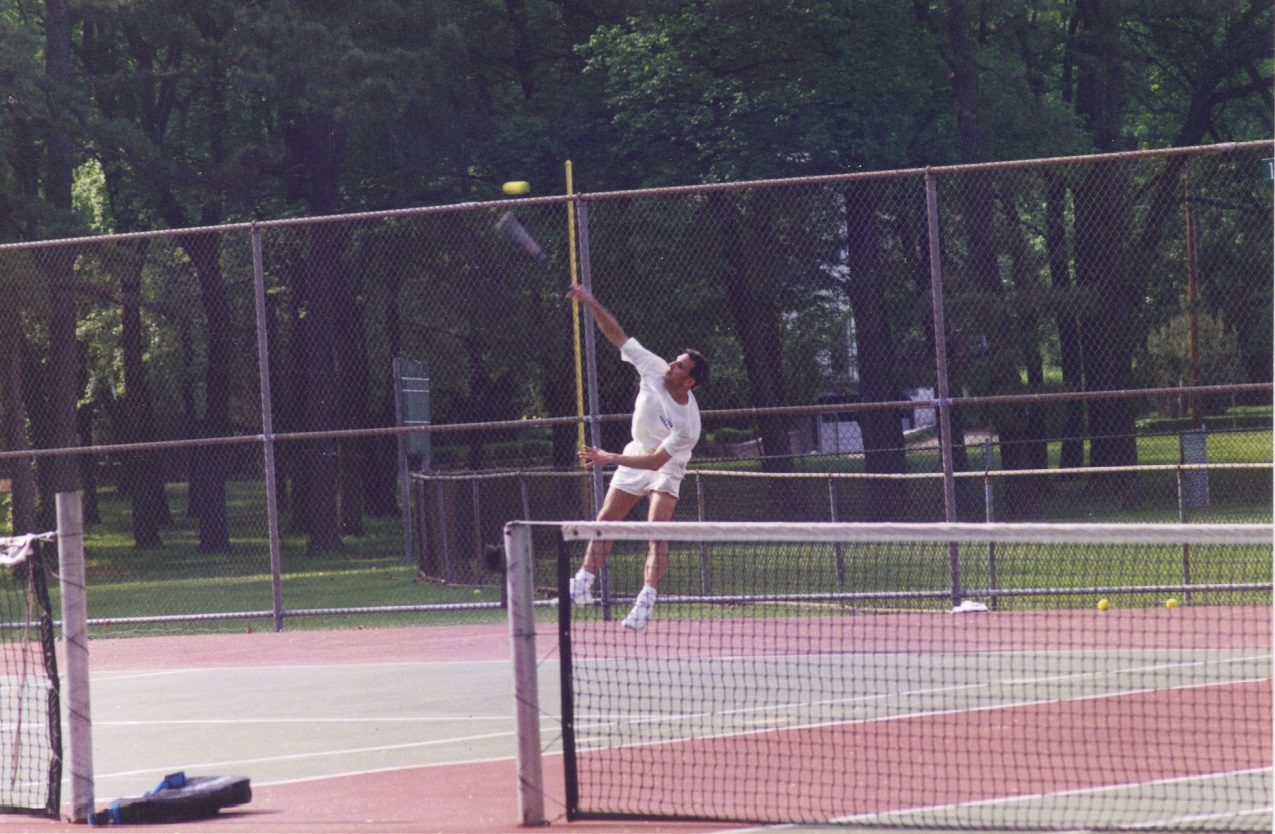
Playing third singles for Needham High School, 1995
The last match of my high school career, I lost 6-1, 4-6, 4-6 on the same Brookline courts where I gave that number-one gesture earlier in the season. Served me right. Karma. However you want to say it, the bottom line was there was some justice in losing a tough match to that team on that court after the stunt I had pulled.
In both the second and third sets, I was serving at 4-4, 30-all. Both times, my opponent won the pivotal fifth point, broke me, and went on to win the set. In tennis, all points are not created equal. One can lose the majority of points or games in a match, yet still win it. In fact, I outscored my opponent in games (14 to 13) this particular day, but he was the one who walked away victorious. The outcome of matches often hinges on how you respond in just a few key situations. Either you rise to the occasion and respond appropriately or you do not. Such is tennis, and such is life.
“I just could not do what they could do; it was like we were playing two different sports.”
Late that summer, I arrived at Tufts University for freshman year and attempted to make the NCAA team as a walk-on. Approximately 60 of us were trying out for two open spots on the roster. I made the first wave of cuts, but did not survive the second. Still, I was not ready to give up on the idea of playing college tennis just yet, so I kept on showing up to the team practices and hit with the guys. Not until Coach Watson gave me a uniform and put me in the lineup for a JV match that spring did I realize he had reconsidered and added me to the roster.
College tennis was an enlightening experience. All of my teammates were better than me, most of them by a lot. Each of them had been the best player in his high school, a status to which I could not relate. Incapable of even holding my own against most of them, I frequently got blown off the court in practice. I just could not do what they could do; it was like we were playing two different sports. The holes in my game that I had been able to work around in high school were routinely exposed at the college level. Coach did not understand how I often failed to execute shots and plays that were so easy for my teammates. His frustration with me showed through sometimes, not in a Bobby Knight sort of way, but more through glares and occasional harsh words, yet he kept me on the team and for that I was grateful.
While I did manage to win some singles and doubles intercollegiate matches, I cannot specifically remember even one of those victories in any sort of detail. By and large, the fragments of matches that I do recall have coalesced into a hazy memory of getting destroyed.
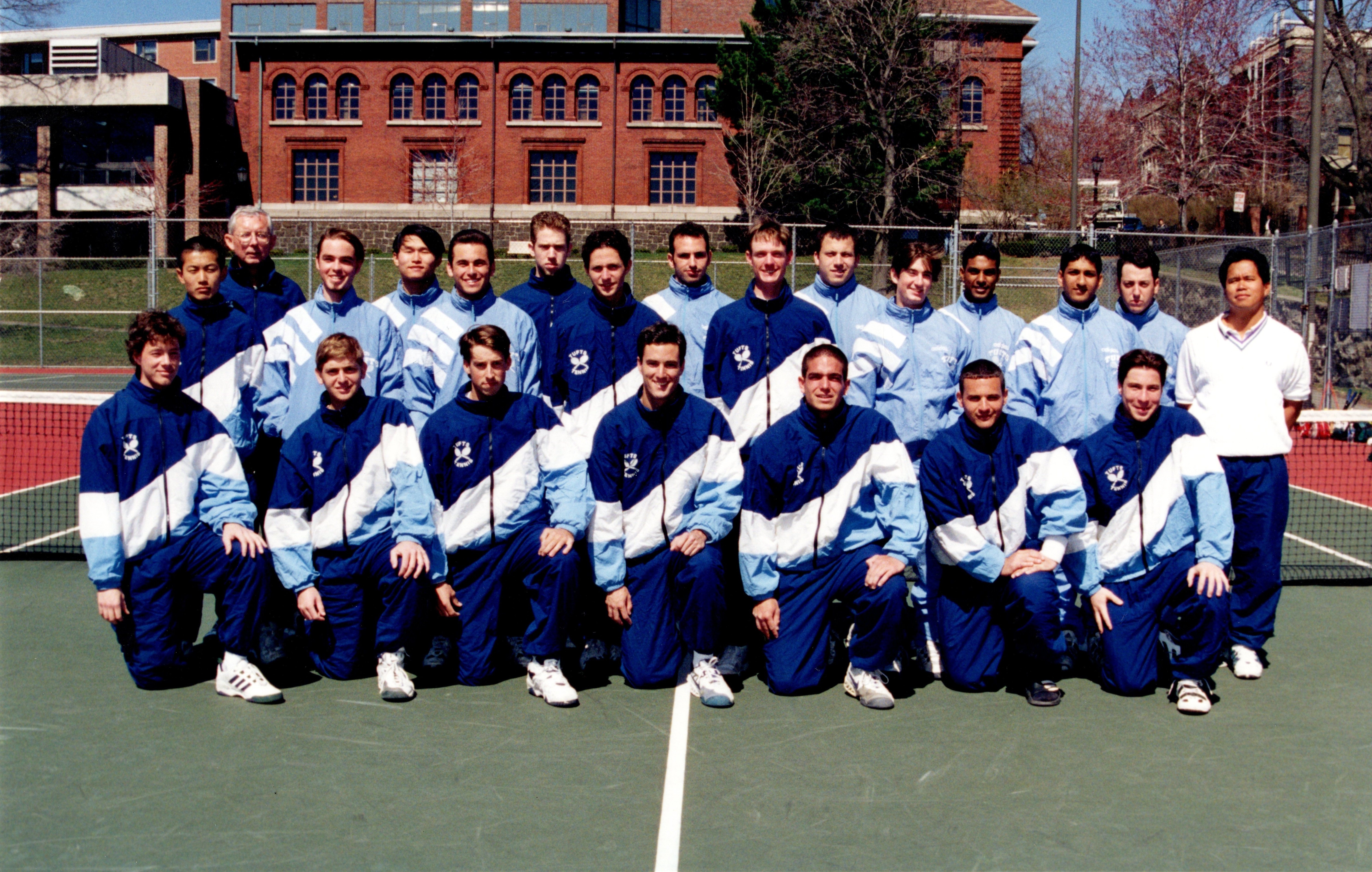
1997 Tufts University men’s tennis team (I am in the center of the back row.)
“I could not stand at the sink and shave without having to take a break in the middle to stretch.”
During the offseason between sophomore and junior year, I trained like a madman. Although I did not look it, I had gotten myself freakishly strong. In the weight room, guys much bigger than me used to watch with confusion as I bench pressed nearly twice my body weight. I sprinted up hills, ran demanding interval workouts that I remembered from my high school track days, performed footwork drills at a court near my house, and practiced with the Tufts Assistant Coach who lived in a neighboring town. That pre-season, I held my own with, and even beat, some of my teammates who had blown me out of the water the past two years. Playing as well as I was, I thought I had an outside shot at even moving up from JV and playing some varsity matches.
Before the season began, Coach insisted that I see a doctor for my long-standing back pain. Since I was 14, I had lived with chronic pain that often radiated down my right leg. My pediatrician never seemed to see it as a big deal and therefore neither did I. By that pre-season, however, the pain was so bad that I could not walk the two blocks back to my dorm after practice without needing to stop and stretch on the sidewalk. I could not stand at the sink and shave without having to take a break in the middle to stretch against the bathroom wall. When Coach ordered me to see a specialist before he would clear me to play the season, I told him it was a waste of time. I was fine, I insisted.
“My new primary care doctor told me I had post-traumatic stress disorder (PTSD). Although some of my friends could tell I had changed, I largely kept my struggles to myself.”
A sudden look of seriousness spread across said specialist’s face as he held up the x-ray he had ordered and viewed it for the first time. My life has never been the same since that moment. To my complete surprise, it turned out that I had a tumor on my spine. Instead of fretting over whether I would make varsity or again be on JV, I worried about whether the tumor was benign or malignant. While my teammates prepared for the season, I did my best to ready myself for immediate surgery.
I remember looking out the window of my hospital room a day or two after my operation and watching the red line trains ride in and out of the Charles/MGH stop. “Those passengers are participating in life,” I thought, while I was absent. My classes were still going on, my teammates were still practicing, yet I was hospitalized. Back when I was in high school, being home sick from school yielded a sort of unsettling depression and anxiousness because I was not where I belonged; I was not living my life. Being in the hospital generated that same feeling, but to an exponentially-greater magnitude.
Death is a topic to which I had given little thought until I experienced anesthesia. My expectation was that being under would mimic sleep. Instead, there was no dreaming, no indications at all from my vantage point that I was in existence. I closed my eyes, then opened them, and in between was a void of which I had no memory. It was as if for that period of time I wasn’t – period. I thought to myself, “This must be what death is like.”
My hospital roommate was in bad shape. The brain tumor that he previously had removed had grown back and he had to have it removed for a second time. This time, he lost vision in one of his eyes as a result. While my brother and I were going for a short walk down the hospital’s corridor, a dead patient was wheeled past us on a gurney.
After what I witnessed and went through myself, I was scarred, more figuratively than literally, and I felt very, very, very mortal. After I got home, I assumed the worst. A headache meant a brain tumor. Abdominal pain meant colon cancer. My new primary care doctor told me I had post-traumatic stress disorder (PTSD). Although some of my friends could tell I had changed, I largely kept my struggles to myself. Only my doctor and my girlfriend knew the internal turmoil I was experiencing.
In hindsight, I am surprised my doctor did not send me to a therapist, or that I did not figure out on my own that I needed help. Part of me rejects the PTSD diagnosis because there are people out there who truly have PTSD – war veterans, rape survivors, first responders, etc. – and their ordeals should not be disrespected, cheapened, or watered down by my experience. Whether or not I really had PTSD, the fact was that I was struggling and it took me the better part of a decade to get over the emotional toll of my surgery. Years went by before I could ride the red line through that Charles/MGH stop and even look in the direction of Mass General without triggering horrible memories of how it felt to be on the other side of those hospital windows.
“That was no way to live no matter what my abs looked like.”
While I did return to the Tufts tennis team a couple months after my operation, by season’s end it was clear that my back was no longer fit for the sport. The decision I knew I had to make was so difficult for me that I could not even express it to Coach Watson face to face. Instead, I wrote him a letter thanking him for everything and explained why I had to leave the team. I sat out what would have been my senior season.
For the next four years, I played no tennis except for rare occasions when I casually hit around with a friend. Fueled by an intense fear of getting sick and dying, I spent these years doing everything I could to take care of my health. Although I hated swimming, I picked it up on the advice of my neurologist. I performed every core exercise I knew and added new ones along the way. Even though it meant sometimes going to bed when it was still light out, I spent nine hours in bed each night, every night. I paid more attention to my eating than I have at any other time in my life, including now. Guys in the locker room used to talk about my abs.
In the film Across the Universe, Jude says to the Vietnam veteran, “You don’t seem too messed up,” to which he responds, “Well, everything below the neck works fine.” Similarly, even though my emotional health was in disarray, I looked okay from the outside, and my back and body as a whole were getting stronger.
I often talk with my patients about living life in balance. At that point in my life though, I was anything but in balance. After turning down plans with friends so I could exercise after work and go to bed early, some of them began to distance themselves from me and stopped extending invitations. My insistence on only eating food I had brought from home kept me from joining co-workers for lunch and my rapport with them weakened. My stress level was so high that I often woke up nauseous in the middle of the night and sometimes vomited. A bottle of Maalox tablets was a permanent fixture at my bedside. While my physical fitness was fantastic, my life was filled with rigidity, unhappiness, and a whole lot of fear. That was no way to live no matter what my abs looked like.
“They were telling me their game plans without even realizing it.”
After four years away from tennis, my back was feeling well enough where I felt ready to try the sport again. I moved to western Massachusetts, joined a new gym, and saw on the bulletin board an ad looking for players to join a men’s United States Tennis Association (USTA) team. The captain, Scott, and I got together to hit at Hampshire College. Having not played in so long, I was terrible. As if I was playing the sport for the first time, I had no idea where the ball was going when it left my racquet. Still, Scott let me on the team and he introduced me to some very nice teammates with whom I began to regularly practice. The rust wore off.
My time away from playing the sport afforded me an opportunity to see it from a different perspective. Not just to see it, but to really consider it, to experience tennis from a macro vantage point from which I had never viewed it before, to understand the flow of the game, why players do what they do in certain situations, what separates the winner from his or her opponent, and other complexities that I never took the time to examine and absorb when I was too busy focusing on my first-hand experience.
Although I never was again the same player physically that I had been in college, I returned to the sport a much more intelligent player. I was more observant than I ever had been when I was younger. Subtleties often gave away my opponent’s next move. The opening of his racquet face signaled a drop shot. Like a change in arm slot tips a pitch, a slight shift in grip indicated the kind of serve coming my way. A quick peak out the corner of my opponent’s eye revealed his target spot. Other times it might have been what a player did, or did not do, in warm ups to hide a weakness or show off a strength. Small talk before the match or on changeovers, whether he looked me in the eye or not, and his posture, these were all windows into his state of mind. They were telling me their game plans without even realizing it.
That’s not to say that I was always able to take advantage of these insights or that my own game was absent of faults. Certainly, I ran into players who exploited my weaknesses, outsmarted me, or blew me off the court with power, but those were the exceptions rather than the rule. After going 11-1 for Scott’s team, I moved up to a more challenging USTA league the next season. The players could do everything a little bit better than in the previous league: move quicker, hit harder, play more consistently, etc. After losing two matches early in the season, I adjusted and went on a run. Next season, I was undefeated and had more match wins than I did double faults. My baseball-playing brother got a kick out of it when I compared my statistical achievement to Bret Saberhagen’s 1994 season with the Mets when he had more wins than walks. All told, three years went by before I lost again.
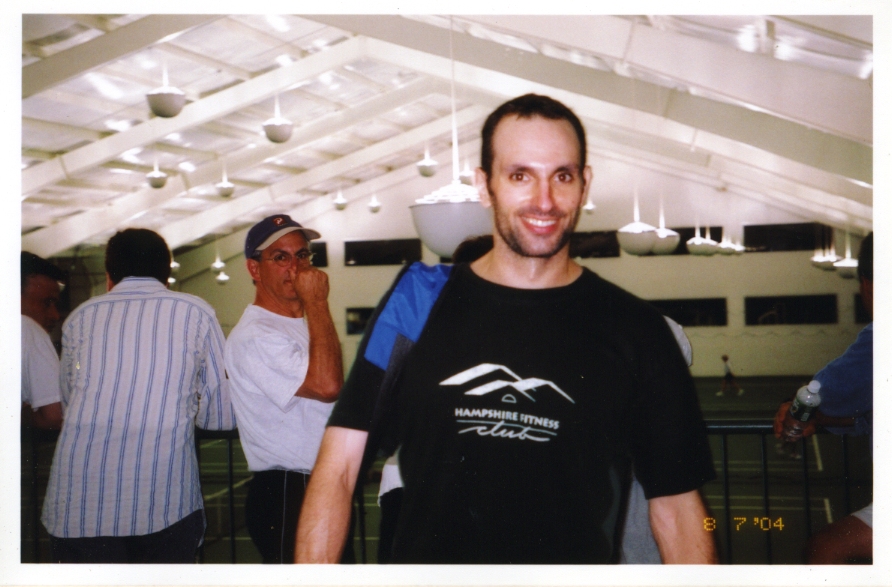
Immediately after upsetting one of the best players in the USTA Districts tournament, 2004
“I thought to myself, ‘Someday I will look back on this and laugh.’ When that day comes, I will let you know.”
In the summer of 2006, I rode my bicycle from Seattle to Boston for charity. One morning outside of Eureka, Montana, I fell off my bike and hurt myself. I wish I had a more exciting or heroic story to tell, but the truth is that I was not even moving at the time of my fall. In the process of mounting my bike, I lost my balance and started to lean to my left. As I tried to plant my left foot on the ground, my cleat accidentally glanced the pedal and clipped in. With no way to stop my momentum, I fell over to my left and landed on my back. Because I was wearing a backpack, my spine forcefully hyperextended upon impact. Although I did not know it at the time, I had fractured some bones in my spine near the surgical site.
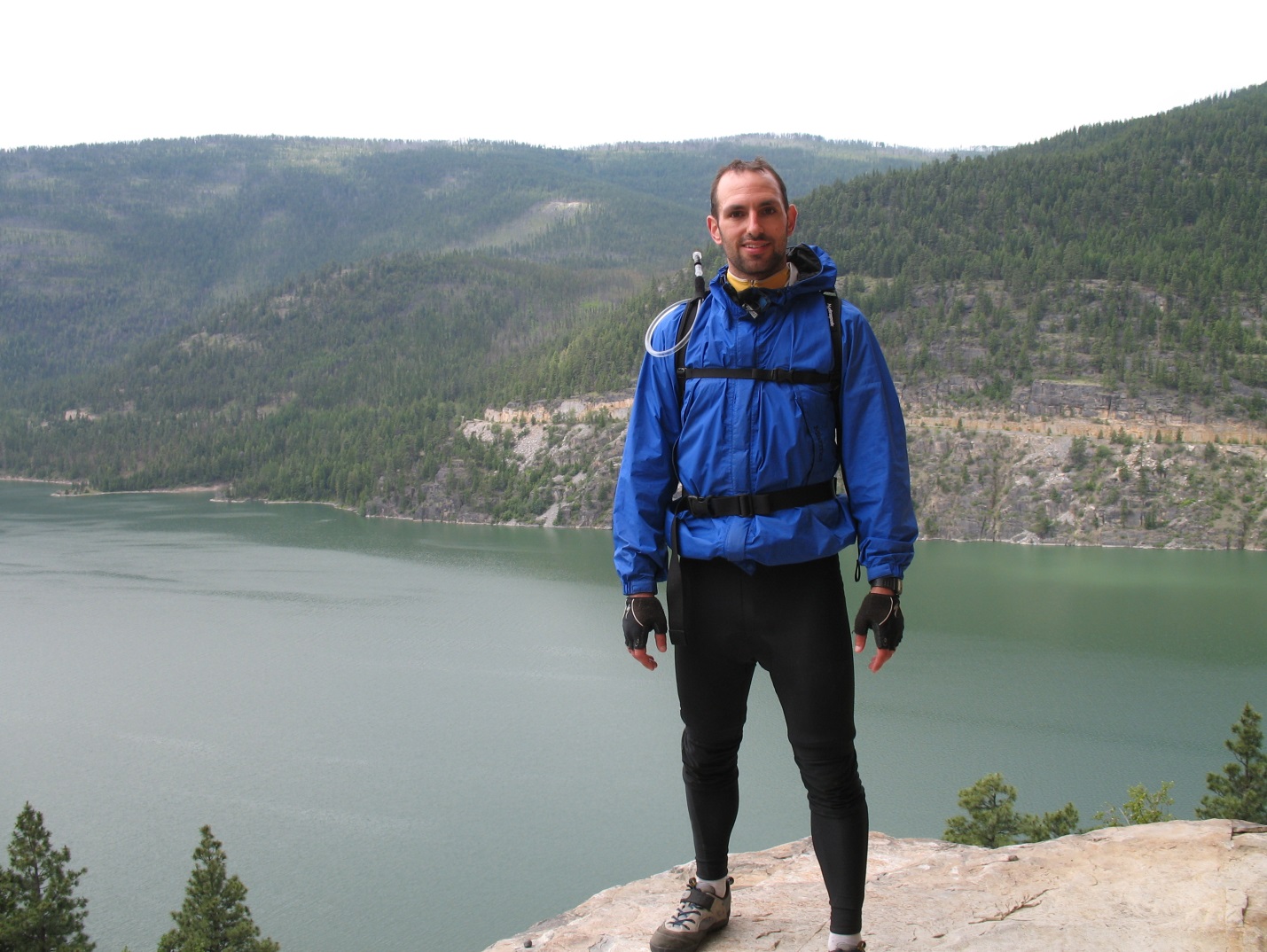
Standing over Lake Koocanusa in Montana a few minutes before my accident, 2006
In that moment, all I knew was that I was in a tremendous amount of pain and I was having trouble moving because the muscles in my back and hips had completely locked. Reaching Eureka, which was just a few miles down the road from where I fell, was a painful struggle. When I got into town, I found a gas station and went into their bathroom. Only after using the toilet did I realize there was no toilet paper, and my back was so bad that initially I was unable to stand up. There I was, injured, thousands of miles from home, stuck on the toilet, unable to wipe, unable to stand, and I thought to myself, “Someday I will look back on this and laugh.” When that day comes, I will let you know.
Although I managed to finish the trek back to Boston, my back was never quite the same again. When I got home and resumed playing tennis, I knew I was not right physically and my confidence on the court was gone. After starting the season 1-2, I went to the neurologist, then to a couple of surgeons, got the bad news about the fractures, and stopped playing. Because my appreciation for the sport had deepened since college, leaving the sport behind for a second time was even harder than the first time around. To date, I have not played competitive tennis in over seven years.
“Balance is the foundation of a healthy lifestyle. Sometimes it takes going through a period of imbalance to come out on the other side and find a happy medium between taking care of your health and taking care of who you are.”
Others have talked about the parallel between tennis and life much more eloquently than I can. Some mention the loneliness of a tennis player, but there is a harsh beauty about having sole responsibility for your actions. Everything you do right and wrong, every act of sportsmanship and gamesmanship, every sound strategy and dumb idea, every shot made under pressure and choked away, they are all yours. You own them all. Together, they comprise a bouquet that defines you as the player that you are.
Consequently, when you make a mistake, you have to face the fact that nobody else is to blame and accordingly use it as a learning opportunity to grow. Conversely, when you do set out to execute a shot or strategy and you make it a reality, there is a peaceful satisfaction, a sense of well-earned serenity, that comes with knowing that you made it happen. One of the best feelings in the world is launching a topspin lob over your opponent’s head, tracking the ball as it arcs through the air, and, out of the corner of your eye, noticing him turn his back and helplessly slump his shoulders as he discovers what you already knew from the the moment the ball left your strings: It is landing in.
At the same time, the ultimate outcome of a match is sometimes out of our hands. You can do everything in your power to win, dig as deep as you possibly can, and still lose. In this kind of defeat, you learn that there are incidents in life that are not up to us. We are only somewhat in control of our own destiny, and we have to roll with events and outcomes that do not go our way.
This lesson comes into play frequently in my work as a dietitian. Some people act as if they can avoid morbidity and mortality if only they get more strict with their food intakes and more rigid with their lifestyles. In other words, if only they take things up a notch, everything will be okay. It can be hard to accept that we will all die, our bodies are not designed to last forever, and if we are lucky enough to be spared fatal accidents and malicious acts, we will each eventually succumb to a condition of some sort. The truth is that we can minimize our chances of getting sick and dying prematurely, but it is a matter of risk reduction, not risk elimination.
Given our uncertain futures, we need to make sure we do not get so caught up in trying to take care of our health that we lose ourselves and the pleasurable aspects of life in the process. I learned this lesson the hard way in the years after my surgery. Balance is the foundation of a healthy lifestyle. Sometimes it takes going through a period of imbalance to come out on the other side and find a happy medium between taking care of your health and taking care of who you are.
My friend, Ben, who gave me tennis lessons when I was just starting to play, could tell you all about life’s unpredictability, but he eventually died of the tumor that kept him from playing the only season in which our high school careers overlapped. He was only 25 when he passed away 15 years ago. To this day, he remains the single nicest and most considerate person I have ever met. Sitting at his funeral, I felt not just sadness, but an overwhelming sense of unfairness: Not only was Ben cheated out of life, but life was cheated out of Ben. Despite the time that has gone by since Ben’s passing, I still think about him often and how much better I would be to everybody in my own life if only I could be at least a little bit more like him.
“Everybody belongs somewhere; everybody has a home.”
When my back suddenly and dramatically worsened this past fall, the idea of surgery was presented to me. Not only would an operation improve my pain, fix some of my spine’s structural issues, and increase my function, the surgeons said it could also allow me to return to competitive tennis. However, given how awful my first back surgery experience was, my resistance to a second surgery was strong. As rest, physical therapy, medications, injections, and acupuncture showed their inability to fix what is really a structural problem, I knew I had to give surgery more consideration.
In an attempt to work through my ambivalence, I sought opinions from six surgeons, discussed the dilemma with Joanne, and began to write this document. Whether trying out for a team that I thought I had no shot of making, sticking around after I had been cut or told to cut myself, or coming back (twice) after my first back surgery, I have always done whatever I could to stay in the game. The realization that ultimately enabled me to make my decision was discerning that choosing to undergo, not decline, surgery represents a continuation of this long-held personal mission. This turning point marked the resolution of my ambivalence. Today, the day of my surgery, my mission continues.
We are only hard-wired to an extent. If I was born into a different culture, perhaps I would have pursued cricket, or in a different time, jousting. Perhaps I could reinvent myself even now, maybe take up chess or painting or get more involved in music again. However, my efforts to refocus my life in the last seven years have done nothing to fill the hole, which feels just as deep now as it did upon its creation. Without tennis, I am not the same person. It has woven itself into my life’s fabric so tightly that it is part of how I self-identify. I am a tennis player. Everybody belongs somewhere; everybody has a home. I know where I belong, and I hope that with patience, hard work, and the tempered resolve to wake up each morning and inch one day closer, I can make it back there.
